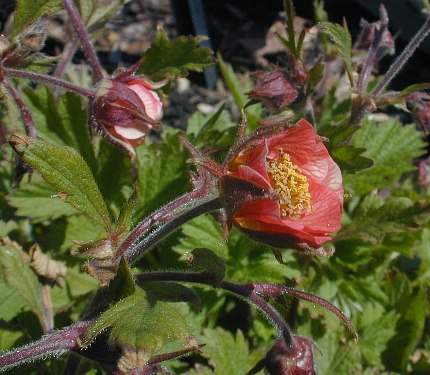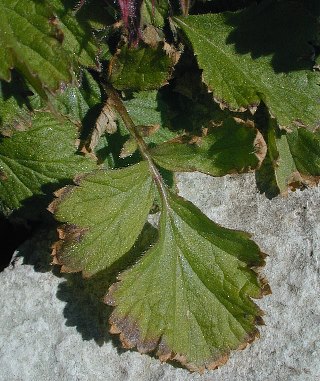Description: This herbaceous perennial wildflower is about 1-2' tall. Alternate compound leaves occur primarily along the lower half of each hairy stem. These leaves are odd-pinnate; they are up to 8" long and 2" across. The lower leaves have 5-7 leaflets, while the sessile upper leaves have 3 leaflets. The terminal leaflet is much larger than the lateral leaflets. The leaflets are coarsely serrated, slightly hairy, rough-textured, and medium green; the terminal leaflet is sometimes divided into 3 lobes. In addition to these leaflets, the lower leaves have tiny secondary leaflets that are inserted between the lateral leaflets.

The upper stems
terminate in nodding cymes of flowers. The branches of each cyme are
dark purple and very hairy. Each flower is ¾–1" across, consisting of 5
dull red to pale purple petals, 5 dark purple sepals, numerous stamens
with yellow anthers, and numerous pistils in the center. Sometimes the
inner sides of the petals are pale yellow; regardless of color, they
are conspicuously veined. The hairy sepals are ovate in shape; they are
about as long as the petals. Between each pair of sepals, there is a
linear bract that is dark purple and hairy. The blooming period occurs
from late spring to mid-summer and lasts about 1-2 months. Each pistil
is
replaced by a flattened achene with a long persistent style; the style
is hooked toward its tip and often pubescent. The root system is
fibrous and rhizomatous. Dense clumps of plants are often formed from
the rhizomes.
Cultivation:
The preference is partial to full sun, wet to moist conditions, and
cool to mild summer temperatures. Various kinds of soil are tolerated.

Range & Habitat:
Water
Avens is restricted to northern Illinois, where it is rare and native
(see Distribution
Map). Because this species has not been observed in natural
areas of the state for several decades, it may be extirpated because of
destruction or degradation of habitat. Water Avens has a circumboreal
distribution in North America, Europe, and Asia; northern Illinois lies
at its southern range limit. Habitats include White Cedar fens (in Kane
County), bogs, marshes, and soggy meadows. This species is sometimes
cultivated in gardens.
Faunal Associations:
According to Mueller (1873/1883), the flowers produce both nectar and
pollen; they are pollinated primarily by bumblebees. Mueller also
observed honeybees, long-beaked Syrphid flies (Rhingia sp.),
and Sap beetles (Nitulidae) visiting the flowers for
nectar or pollen. Because the achenes have persistent styles with
hooked or jointed tips, it is possible that they are distributed by
birds or mammals.
Photographic Location:
A flower garden at the University of Illinois Arboretum in Urbana,
Illinois.
Comments:
This is one of the more showy species in the genus. Other Geum
spp. (Avens) have smaller flowers that are white or yellow.
An exception is Geum triflorum (Prairie Smoke),
which has nodding red to purple flowers. Unlike Water Avens, the petals
of Prairie Smoke are mostly hidden by the sepals. The achenes of
Prairie Smoke have long plumose styles that are distributed by the
wind. In contrast, the achenes of Water Avens have styles that are
jointed or hooked; they are probably distributed by animals, as noted
above. Prairie Smoke typically occurs in dry gravelly prairies, while
Water Avens is found in various wetland habitats. Another common name
of Geum rivale is Purple Avens.